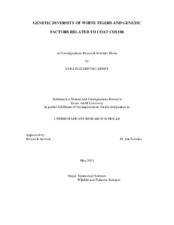| dc.description.abstract | White tigers are greatly cherished by the public, making them valuable to zoos and breeders. Unfortunately, a number of health issues have occasionally surfaced within some of the white tiger population such as neurological and facial defects. There is interest amongst private tiger breeders to determine if these maladies are associated with the coat color or breeding practices, and to find ways to prevent these health issues. The genes involved in producing the white phenotype and the disease phenotype are currently unknown. Furthermore, the relationship between the genes associated with coat color and levels of inbreeding also remain unknown.
Microsatellites are a tool frequently used by geneticists and ecologists alike. These segments of highly repeatable DNA mutate frequently and are variable in length. Thus microsatellites can be used to determine heterozygosity within a population by detecting the alleles present at the loci of interest. The amount of heterozygosity within a population can be indicative of the amount of inbreeding present and overall levels of genetic diversity. A panel of twelve microsatellites was used to analyze heterozygosity, thus inferring the levels of genetic diversity present. Among the tigers sampled, estimated heterozygosity was determined to be 0.761 in white tigers and 0.772 in orange tigers.
The genes Melanocortin-1-Receptor (MC1R) and Agouti Signaling Protein (ASIP) have been found to affect coat color phenotypes in other species similar to that of the white tiger, making them ideal candidates for this project. These genes work antagonistically to each other in production of melanin. MC1R is responsible for the production of α-melanocyte stimulating hormone (α-MSH) while ASIP silences this activity. Thus, a loss-of-function associated with MC1R or a gain-of-function associated with ASIP could lead to reduced pigment production. This study continues the initial investigation by focusing on sequencing MC1R. Differences in the nucleotides and amino acids of the sequences were compared through alignment in Sequencher. At this time a causal mutation has not been found within exons 1 and 2 of ASIP or MC1R. | en |


